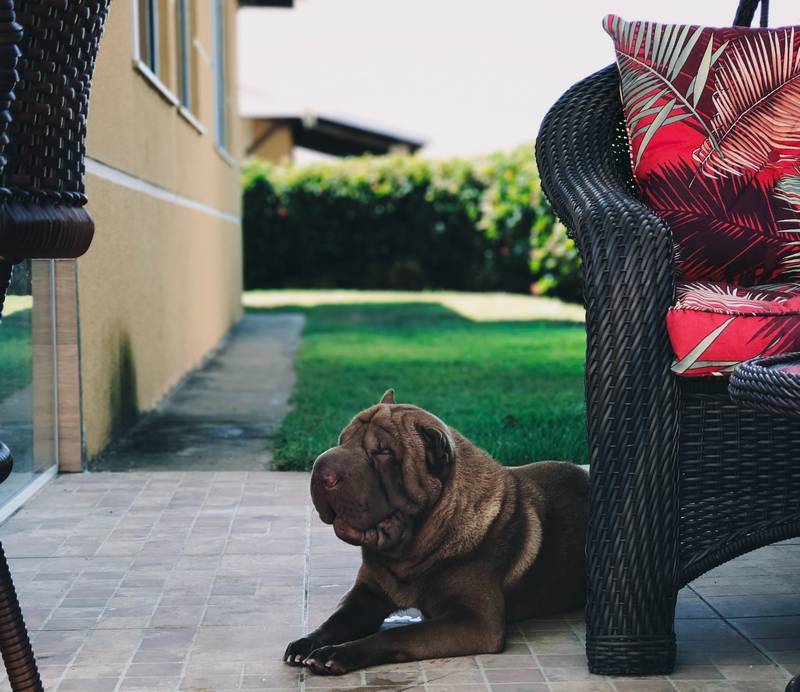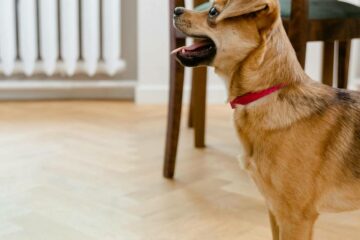How to Stop Dog Peeing on Outdoor Furniture [5 Step Fix!]
Having a dog pee on your outdoor furniture can certainly put a damper on your enjoyment of a beautiful day. Not only is it unsightly, but it also brings about a significant challenge for dog owners. Why do dogs even mark their territory on furniture, and more importantly, how can you stop it?
In this article, we’ll delve into understanding this peculiar dog behavior, from the triggers to effective deterrents. We’ll also discuss some tips on dog-proofing your furniture and cover what to spray on your patio pieces to keep your furry friend at bay.
Ready to reclaim your outdoor space? Let’s get started!
How to Stop Dogs From Peeing on Outdoor Furniture

To keep dogs from peeing on outdoor furniture:
- Learn your dog’s pee schedule. When it’s time for them to go, grab some treats and put them on their leash, and take them out to a spot that you’d like them to go.
- Be patient and wait for them to pee. When they do, give them positive praise and a treat immediately. Keep repeating this and your dog will form a positive connection with urinating on the grass, and not on your patio furniture.
- Now, we’ll make a spray to deter your dog from peeing on outdoor furniture in specific areas. First, make a 50/50 mix of distilled white vinegar and water in a spray bottle. Next, spray this on any spots where your dog is marking on outdoor furniture.
- The mixture is safe for nearly all surfaces and fabrics including wood and composites, but should not be used on metal as it can be corrosive over time. If your outside furniture is metal, instead spray the mixture on the ground or decking surrounding the pieces. Avoid plants as the mix can kill them.
- Wait about an hour. The vinegar smell will become undetectable for you once the spray has completely dried. Your dog will continue to be able to detect the scent and will remain deterred from urinating there.
These steps will get your dog to stop peeing on outdoor furniture, but it’s important to remember that the underlying behavioral issue (anxiety, marking, etc.) that was causing all of this to begin with will still be present. And until you address that, any positive changes you see are only going to be temporary.
“Well, how do I make them last then?”
By getting your dog to truly choose to follow your direction, that’s how. I tried many times to write out how you can do that before deciding it made more sense to just link you to the free video series that explains it better than I’d ever be able to.
The series is by a man named Dan who is one of the world’s leading dog obedience trainers. In it, he teaches you how to put an end to things like your dog peeing on your outdoor furniture and all other misbehavior using his fast and easy-to-follow methods.
In the first video, Dan will reveal to you why the two most common methods of dog training only doom you to failure. You can watch the video now by clicking here. Follow the proven system he’ll show you in his series and you’ll never have to spend another second worrying about your dog peeing on the outdoor furniture ever again!
How to Keep Dogs off Outdoor Furniture

When you’re faced with the question of how to keep dogs off outdoor furniture, there are several strategies you can implement. Dogs are naturally curious creatures, and the allure of a comfy chair or couch can be too much to resist. Here are a few methods to help deter your furry friend from claiming your outdoor furniture.
Training
Training is one of the most effective ways to prevent dogs from getting on furniture. Use positive reinforcement to reward your dog for staying off the furniture and redirecting them to a dog bed or another appropriate spot. Consistency is key when it comes to training. More on that in the first section of this article.
Use Covers
Covers can be an effective deterrent for dogs. You can use plastic, aluminum foil, or specialized pet deterrent mats on your outdoor furniture when it’s not in use. Most dogs don’t like the texture of these materials and will avoid climbing on them.
Create a Dog-Friendly Space
Creating a dog-friendly space can help keep your dog off your outdoor furniture. If your dog has their own comfortable and appealing spot, they’re less likely to be attracted to your furniture. You can create this space by using a comfortable dog bed or outdoor dog lounger.
Use Natural Deterrents
Certain smells can deter dogs from approaching certain areas. Spraying your outdoor furniture with a natural, pet-safe deterrent spray that dogs find unappealing can help keep your dog off your furniture. We have instructions for creating one in the first section of this article.
You’ll want to get a handle on this issue before it gets any worse. Otherwise, you’ll find your dog peeing on furniture inside, peeing on the doorstep, peeing at the back door, or having that misbehavior spread to other problems like barking in the garden.
Dog Proof Outdoor Furniture: How To
If you have a dog and love to spend time outside, then protecting your outdoor furniture can be a big concern. Here are some steps to help you dog-proof your outdoor furniture:
- Use Outdoor Furniture Covers: Covers can protect furniture from damage, including chewing, scratching, and hair accumulation. Ensure the covers are durable and fit snugly around your furniture.
- Choose Dog-Friendly Materials: When buying new outdoor furniture, consider materials that are resistant to damage from dogs. For example, metal or high-density polyethylene furniture can withstand more wear and tear than wicker or rattan.
- Provide Plenty of Chew Toys: If your dog is busy with their own toys, they’re less likely to chew on your furniture. Provide a variety of toys to keep them interested and occupied.
- Use Dog Repellents: Certain smells can deter dogs from approaching your furniture. Go back to the first section of this article and we’ll teach you how to create one.
Why Do Dogs Pee on Garden Furniture?
Dogs might pee on garden furniture due to a few reasons, all typically centered around marking territory, an illness, or a behavior issue. Here’s the lowdown on why this might be happening:
- Marking Territory: Dogs, especially males, often use urine to mark their territory. If your dog pees on your garden furniture, they may be leaving a scent mark to communicate with other dogs that this is their territory.
- Behavioral Issues: Behavioral issues like anxiety, fear, or confusion can cause a dog to urinate in inappropriate places. Changes in environment, like new furniture, can also trigger this behavior.
- Medical Conditions: Certain medical conditions such as urinary tract infections, kidney disease, diabetes, or incontinence can cause dogs to pee more frequently and in unusual spots.
- Lack of Training: If a dog hasn’t been fully house-trained, they might not understand that it’s not okay to pee on your garden furniture.
If your dog has started peeing on your garden furniture suddenly or frequently, it’s worth talking to a vet or dog behaviorist to get to the root of the problem. Medical conditions can often be managed with treatment, and behavioral issues can often be improved with training and consistency. More on how to do that in the first section of this article.
What to Spray on Patio Furniture to Keep Dogs From Peeing
When your dog decides to mark your patio furniture as their territory by peeing on it, it can be frustrating. However, there are sprays you can use that will deter this behavior. Here are some solutions:
- Commercial Dog Repellents: There are numerous commercial dog repellents available in pet stores or online. These usually contain scents that dogs find unpleasant, discouraging them from peeing on your patio furniture.
- Citrus Spray: Dogs generally dislike the smell of citrus. You can make your own deterrent spray by mixing water with lemon or orange essential oils. Spray this mixture on your patio furniture to keep your dog away. However, test a small area first to ensure the oil does not discolor your furniture.
- Distilled White Vinegar and Water: The strong smell of vinegar can also act as a deterrent. A solution made from equal parts distilled white vinegar and water can be sprayed on the areas where your dog tends to pee. As with the citrus spray, test this on a small, unnoticeable area first to ensure it won’t damage your furniture.
Remember, these sprays should be used in conjunction with training to discourage your dog from marking. It’s essential to clean the area thoroughly first to remove any existing scent markers that may attract your dog back to the same spot. Go back to the first section of this article to learn more on correcting this issue.
How to Get Dog Urine Out of Wood Furniture
Dog urine can cause unsightly stains and produce a strong odor on your wood furniture. The key is to act quickly to minimize damage. Here’s how to effectively clean dog urine out of your wood furniture:
- Blot the Area: If the urine is fresh, use a clean, absorbent cloth to blot as much of the urine as possible. Avoid rubbing the area as this can spread the urine and potentially push it deeper into the wood.
- Apply Vinegar Solution: Mix one cup of white vinegar with one cup of warm water. Vinegar is a natural deodorizer that can neutralize the smell of urine. Dampen a clean cloth with this solution and gently wipe the affected area. Be sure not to oversaturate the wood.
- Rinse and Dry: After wiping the area with the vinegar solution, rinse by wiping with a cloth dampened with clean water. Then, dry the area thoroughly with a towel or let it air dry.
- Sand and Refinish if Needed: If the urine has stained the wood, you might need to sand the area and apply a new finish. Be sure to match the finish to the rest of your furniture for a consistent look.
Remember, it’s crucial to prevent future accidents by properly house training your dog and limiting their access to your wood furniture. To learn more about how to do that effectively, go back to the first section of this article now.
Dog Keeps Peeing on Outdoor Furniture at Night
If your dog is consistently peeing on your outdoor furniture at night, it could be due to a variety of factors. Nighttime can bring a unique set of circumstances that might trigger this behavior. Here’s what could be going on:
- Marking Behavior: Your dog could be marking their territory, a behavior that might become more pronounced at night when other animals could be more active.
- Anxiety: Anxiety and stress can trigger inappropriate elimination. If your dog becomes anxious at night, perhaps due to noises or being alone outside, they may pee on furniture.
- Limited Access: If your dog doesn’t have access to their usual bathroom spot at night, they might resort to peeing on the furniture.
- Medical Issues: Health problems like urinary tract infections, diabetes, or kidney disease might cause more frequent urination, which can become noticeable at night.
If this becomes a regular occurrence, you may need to consult with your vet to rule out any medical problems. If the behavior is not health-related, then go back to the first section of this article to learn about to work through it using behavioral training.
Dog Pees on Outdoor Furniture All of a Sudden
When a well-behaved dog suddenly starts urinating on your outdoor furniture, it can be quite surprising and unsettling. There could be several reasons for this sudden change, including medical issues, behavioral changes, or a shift in the environment.
- Medical issues: Sudden changes in a dog’s urination behavior can sometimes be a sign of a medical problem, such as a urinary tract infection, kidney disease, or diabetes. If your dog is showing other signs of illness, such as increased thirst, changes in appetite, lethargy, or other behavioral changes, it’s important to consult with your vet immediately.
- Behavioral changes: Dogs may begin urinating on outdoor furniture due to behavioral issues. This can often be linked to marking behavior, especially in un-neutered males. Anxiety can also be a factor, especially if there have been recent changes in the dog’s environment or routine.
- Environmental factors: If you’ve recently moved the furniture or added new pieces, your dog might be confused and think it’s an appropriate place to pee. Dogs can also be attracted to the smells on outdoor furniture, especially if other animals have marked the area.
No matter the cause, it’s important to clean the furniture thoroughly to remove the scent of urine, which can attract your dog back to the same spot. Utilizing positive reinforcement to train your dog to pee in a specific area can also help. Learn how to prevent the behavior in the first section of this article.
Older Dog Peeing on Lawn Furniture
If you’re noticing your older dog peeing on lawn furniture, this can be a frustrating issue. There could be a few reasons why this is happening, and it’s important to understand them so you can take the right steps to address the behavior.
Health Issues
Older dogs can often face health issues that lead to inappropriate urination. Conditions like urinary tract infections, kidney disease, diabetes, or cognitive dysfunction syndrome (similar to dementia in humans) could be causing this behavior. It’s important to consult with your vet to rule out any medical issues.
Behavioral Issues
If your older dog has recently started peeing on lawn furniture, it could be a behavioral issue. Dogs use urine marking as a way to communicate with other dogs. Your older dog could be marking the furniture to assert dominance or because of anxiety.
Incontinence
Incontinence is a common issue in older dogs, and it may be that they’re not intentionally urinating on the furniture but simply can’t hold their bladder. This could be a result of age-related physical changes or medical conditions such as a urinary tract infection.
Lack of Access to Suitable Spot
Your older dog might also be peeing on lawn furniture because they don’t have access to a suitable spot to relieve themselves. Make sure your dog has regular access to a suitable bathroom area, especially if they’re experiencing age-related incontinence.
If your older dog is peeing on lawn furniture, it’s important to address the issue quickly to prevent it from becoming a habit. Learn about how to handle this issue by going back to the first section of this article now.
I’m sure you’re ready to enjoy your outside furniture without having to clean up your dog’s pee first, so I’ll let you begin now. Best wishes with everything, and thank you for reading our article “How to Stop Dog Peeing on Outdoor Furniture.”





